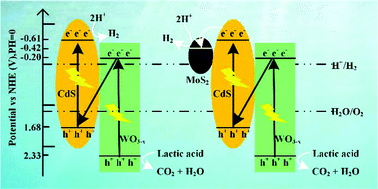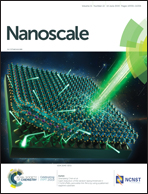Oxygen deficiency introduced to Z-scheme CdS/WO3−x nanomaterials with MoS2 as the cocatalyst towards enhancing visible-light-driven hydrogen evolution†
Abstract
An oxygen deficiency modified Z-scheme CdS/WO3−x nanohybrid with MoS2 as the cocatalyst was synthesized by a microwave hydrothermal method and was used for photocatalytic hydrogen production under visible light irradiation. Loadings of WO3−x and MoS2 as well as the synthesis time of the microwave-assisted hydrothermal process were optimized, and the physicochemical and optical properties of the as-prepared photocatalysts were characterized by various techniques. Results showed that the material with 30 wt% of WO3−x, 0.1 wt% of MoS2 and a preparation time of 120 minutes exhibited the most desirable morphology and structure for hydrogen production. The maximum hydrogen production of 2852.5 μmol g−1 h−1 was achieved, which was 5.5 times that of pure CdS (519.1 μmol g−1 h−1) and 1.5 times that of CdS/30 wt% WO3−x (1879.0 μmol g−1 h−1), and the external quantum efficiency (EQE) reached 10.0% at 420 nm. The improvement of photocatalytic performance could be attributed to the Z-scheme formed between CdS and WO3−x and MoS2 as an electron trap. It is worth mentioning that the size of the composite had a negative correlation with the H2 production rate.



 Please wait while we load your content...
Please wait while we load your content...